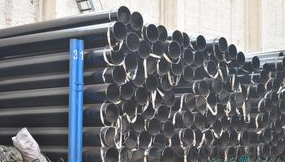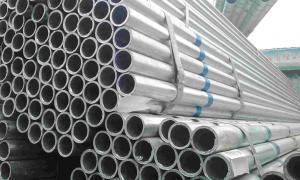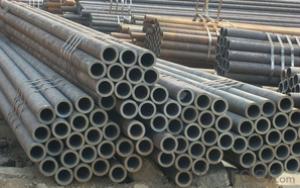Cold Drawn Carbon Steel Seamless Pipe A 335P23 CNBM
- Loading Port:
- Qingdao
- Payment Terms:
- TT OR LC
- Min Order Qty:
- 10 pc
- Supply Capability:
- 30 pc/month
OKorder Service Pledge
OKorder Financial Service
You Might Also Like
Quick Details
| Thickness: | 1.2 - 20 mm | Section Shape: | Round | Outer Diameter: | 12.7 - 168 mm |
| Secondary Or Not: | Non-secondary | Application: | Boiler Pipe | ||
| Technique: | Cold Drawn | Certification: | PED | Surface Treatment: | oil coating |
| Special Pipe: | Thick Wall Pipe | Alloy Or Not: | Is Alloy | ASTM A213: | T2,T5,T9,T11,T12,T22,T23,T91,T91 |
| ASTM A335: | P1,P2,P5,P9,P11,P12,P22,P23,P91,P92 | DIN17175: | 15Mo3,10CrMo910,12CrMo195,13CrMo44 | Grade: | 12Cr1MoV,Cr5Mo,Cr9Mo,12Cr1MoVG,Cr5MoG,A335 P11,A335 P5,A335 P9,A335 P1,A213,A192,A210,A335 P12,A335 P23,St35.8,Cr-Mo alloy,A53-A369,ST35-ST52 |
| Standard: | BS 3059-2,DIN EN 10216-1-2004,DIN 17175,ASTM A213-2001,ANSI A210-1996,ASTM A179-1990,BS,DIN,ASTM |
Packaging & Delivery
| Packaging Detail: | Seaworthy export packing |
| Delivery Detail: | 45 Days |
Specifications
Standard:ASTM A179,DIN17175
Material:SA179,ST35.8
Size:12*1.2-168*20
Manufacture:cold drawn
Heat treating: normalized
Product Description
Commodity: cold drawn carbon steel seamless pipe
Standard&material: ASTM A213 T2,T5,T9,T11,T12,T22,T23,T91,T92, ASTM A335 P1,P2,P5,P9,P11,P12,P22,P23,P91,P92, DIN17175 15Mo3,10CrMo910,12CrMo195,13CrMo44, and equivalent standard and material.
Size range: 12mm*1.2mm - 168mm*20mm
Manufacture method: cold rolled, cold drawn
Delivery condition: Normalized, Normalized and Tempered.
Mill test certificate as per EN10204 3.1B is available.
Third party inspection is acceptable.
Tubes will be ECT+UT.
Packaging & Shipping
Packing: tubes will be packed in bundles tied with steel strips.
Oil coating,varnish,or black painting to be confirmed.
End plastic caps to be confirmed.
External packing by knit bags.
Marking: to be confirmed.
- Q: Can steel pipes be used for marine applications?
- Yes, steel pipes can be used for marine applications. Steel pipes have excellent strength and corrosion resistance, making them suitable for various marine environments. They are commonly used in shipbuilding, offshore structures, and underwater pipelines due to their durability and ability to withstand harsh conditions in saltwater.
- Q: How are steel pipes used in the construction of offshore oil rigs?
- Steel pipes are used in the construction of offshore oil rigs primarily for the transportation of oil and gas. These pipes are used to connect the wells drilled in the seabed to the surface facilities on the rig. They are also utilized for the circulation of drilling fluids, which help maintain stability and cool down the drilling equipment. Additionally, steel pipes are used to construct the rig's structural components like risers, conductors, and caissons, providing strength and support in the harsh offshore environment.
- Q: Can steel pipes be used for conveying sewage sludge?
- Yes, steel pipes can be used for conveying sewage sludge. Steel pipes are commonly used in various industrial applications, including the transportation of sewage sludge. They are strong, durable, and resistant to corrosion, making them suitable for handling the potentially corrosive nature of sewage sludge.
- Q: Can steel pipes be used for the construction of transmission towers?
- Yes, steel pipes can be used for the construction of transmission towers. Steel pipes are commonly used in the construction industry due to their strength, durability, and ability to withstand various weather conditions. They provide a reliable and cost-effective solution for supporting the weight and load of transmission towers, making them suitable for this purpose.
- Q: How do you calculate the buoyancy of submerged steel pipes?
- To calculate the buoyancy of submerged steel pipes, you need to determine the weight of the displaced fluid. This can be done by multiplying the volume of the submerged portion of the pipe by the density of the fluid. The buoyant force is then equal to the weight of the displaced fluid.
- Q: Can steel pipes be used for stormwater management systems?
- Yes, steel pipes can be used for stormwater management systems. Steel pipes are a commonly used material for stormwater management due to their durability, strength, and resistance to corrosion. They can effectively carry and transport stormwater, making them suitable for various applications in stormwater management systems.
- Q: How are steel pipes used in the electronics industry?
- Steel pipes are commonly used in the electronics industry for various purposes such as cable management, structural support, and heat dissipation. They are often used to protect and organize cables and wires, ensuring efficient and organized routing of electrical connections. Steel pipes also provide structural support for electronic equipment, serving as a framework for mounting components and ensuring stability. Additionally, steel pipes are used for heat dissipation, allowing for the efficient cooling of electronic devices, which is crucial for maintaining optimal performance and preventing overheating.
- Q: What are the typical lengths of steel pipes?
- The typical lengths of steel pipes vary depending on their intended use and application. However, common lengths for steel pipes range from 18 to 24 feet (5.5 to 7.3 meters).
- Q: How are steel pipes coated to prevent internal corrosion?
- Steel pipes are coated to prevent internal corrosion through a process called internal coating. This involves applying a protective layer of epoxy or polyethylene coating on the inner surface of the pipes. This coating acts as a barrier between the steel surface and the fluid being transported, preventing the corrosive elements from coming into direct contact with the steel and reducing the risk of internal corrosion.
- Q: What are the common methods for inspecting the integrity of steel pipes?
- There are several common methods used to inspect the integrity of steel pipes. These methods are crucial to identify any defects or weaknesses in the pipes that could compromise their structural integrity and potentially lead to failures or leaks. 1. Visual Inspection: This is a basic method where an inspector visually examines the external surface of the steel pipe for any signs of damage, such as corrosion, cracks, or deformities. It is a quick and cost-effective method, but it may not detect internal defects. 2. Ultrasonic Testing (UT): UT is a non-destructive testing method that uses high-frequency sound waves to detect flaws in steel pipes. A transducer sends ultrasonic waves into the pipe, and any reflected waves are analyzed to identify defects like cracks or voids. UT is effective for both internal and external inspections and can provide accurate measurements of defect size and location. 3. Magnetic Particle Inspection (MPI): This method is mainly used to detect surface or near-surface defects in ferromagnetic materials like steel. Magnetic particles are applied to the surface of the pipe, and if there is a defect, the particles will gather around it, creating a visible indication. MPI is particularly useful for detecting cracks and other discontinuities that may not be easily visible to the naked eye. 4. Radiographic Testing (RT): RT involves the use of X-rays or gamma rays to inspect the internal structure of steel pipes. The rays pass through the material, and a radiographic film or a digital detector records the image. This method is effective in detecting internal defects such as cracks, voids, or inclusions. However, it requires proper safety precautions due to the use of radiation. 5. Eddy Current Testing (ECT): ECT is a non-destructive testing method that uses electromagnetic induction to assess the integrity of steel pipes. An alternating current is passed through a probe, creating an electromagnetic field. Any changes in the electrical conductivity or magnetic permeability of the material due to defects are detected by the probe, providing information about the pipe's condition. These are some of the common methods used for inspecting the integrity of steel pipes. Each method has its advantages and limitations, and the choice of inspection method depends on factors such as the type of defect to be detected, access to the pipe, and budget constraints. Regular inspection and maintenance using these methods are crucial to ensure the safe and reliable operation of steel pipe systems.
Send your message to us
Cold Drawn Carbon Steel Seamless Pipe A 335P23 CNBM
- Loading Port:
- Qingdao
- Payment Terms:
- TT OR LC
- Min Order Qty:
- 10 pc
- Supply Capability:
- 30 pc/month
OKorder Service Pledge
OKorder Financial Service
Similar products
Hot products
Hot Searches
Related keywords




























